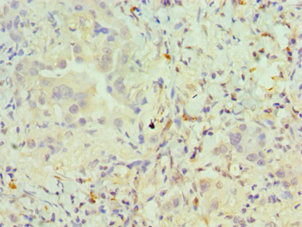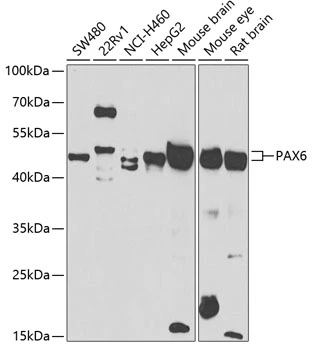![IHC-P analysis of human gastric carcinoma tissue using GTX34957 PAX6 antibody [SPM612]. IHC-P analysis of human gastric carcinoma tissue using GTX34957 PAX6 antibody [SPM612].](https://www.genetex.com/upload/website/prouct_img/normal/GTX34957/GTX34957_20200115_IHC-P_594_w_23060801_795.webp)
IHC-P analysis of human gastric carcinoma tissue using GTX34957 PAX6 antibody [SPM612].
PAX6 antibody [SPM612]
GTX34957
ApplicationsFlow Cytometry, ImmunoFluorescence, ImmunoCytoChemistry, ImmunoHistoChemistry, ImmunoHistoChemistry Paraffin
Product group Antibodies
TargetPAX6
Overview
- SupplierGeneTex
- Product NamePAX6 antibody [SPM612]
- Delivery Days Customer9
- Application Supplier NoteICC/IF: 1-2microg/ml. IHC-P: 1-2microg/ml for 30 minutes at RT. FACS: 1-2microg/106 cells. *Optimal dilutions/concentrations should be determined by the researcher.Not tested in other applications.
- ApplicationsFlow Cytometry, ImmunoFluorescence, ImmunoCytoChemistry, ImmunoHistoChemistry, ImmunoHistoChemistry Paraffin
- CertificationResearch Use Only
- ClonalityMonoclonal
- Clone IDSPM612
- Concentration0.2 mg/ml
- ConjugateUnconjugated
- Gene ID5080
- Target namePAX6
- Target descriptionpaired box 6
- Target synonymsAN; AN1; AN2; Aniridia 1; Aniridia 2; aniridia type II protein; ASGD5; D11S812E; FVH1; MGDA; oculorhombin; paired box homeotic gene-6; paired box protein Pax-6; WAGR
- HostMouse
- IsotypeIgG1
- Protein IDP26367
- Protein NamePaired box protein Pax-6
- Scientific DescriptionThis gene encodes paired box protein Pax-6, one of many human homologs of the Drosophila melanogaster gene prd. In addition to a conserved paired box domain, a hallmark feature of this gene family, the encoded protein also contains a homeobox domain. Both domains are known to bind DNA and function as regulators of gene transcription. Activity of this protein is key in the development of neural tissues, particularly the eye. This gene is regulated by multiple enhancers located up to hundreds of kilobases distant from this locus. Mutations in this gene or in the enhancer regions can cause ocular disorders such as aniridia and Peters anomaly. Use of alternate promoters and alternative splicing results in multiple transcript variants encoding different isoforms. Interestingly, inclusion of a particular alternate coding exon has been shown to increase the length of the paired box domain and alter its DNA binding specificity. Consequently, isoforms that carry the shorter paired box domain regulate a different set of genes compared to the isoforms carrying the longer paired box domain. [provided by RefSeq, Mar 2019]
- Storage Instruction-20°C or -80°C,2°C to 8°C
- UNSPSC12352203



![FACS analysis of 3T3-L1 cells using GTX82816 PAX6 antibody [1C8]. Green : PAX6 Purple : negative control](https://www.genetex.com/upload/website/prouct_img/normal/GTX82816/GTX82816_20170912_FACS_w_23061322_642.webp)


![IHC-P analysis of human gastric carcinoma tissue using GTX34956 PAX6 antibody [PAX6/1166].](https://www.genetex.com/upload/website/prouct_img/normal/GTX34956/GTX34956_20200115_IHC-P_593_w_23060801_651.webp)
